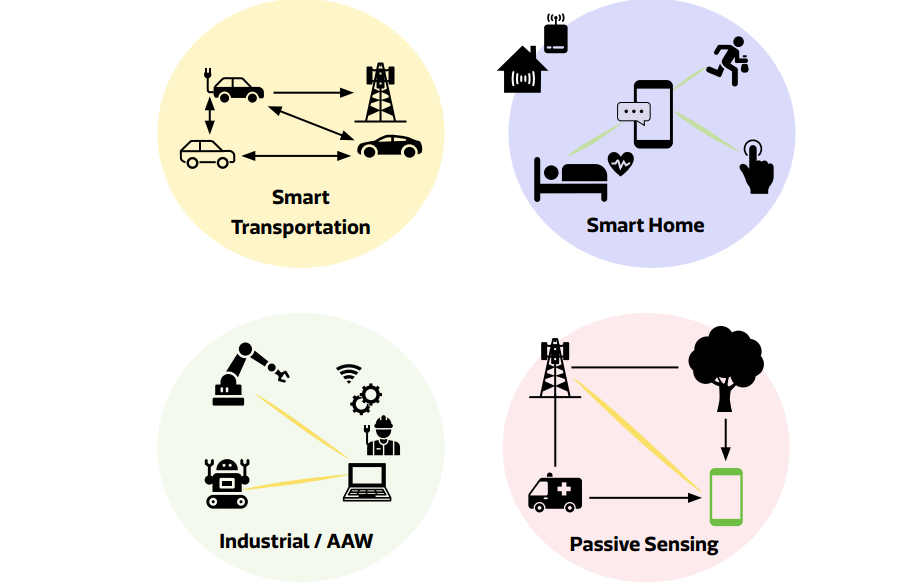The emergence of 6G systems will bring about significant advancements in meeting the needs and desires of users. These systems will operate within the paradigm of Ambient Intelligence AmI, where complexity is managed within the system itself rather than burdening the users. In the context of 6G, the focus will be on responsiveness to user intentions and creating seamless cooperation among system elements such as devices and network nodes. This cooperative approach will optimize the system to meet user needs transparently.
AmI is expected to find a wide range of applications, particularly in cyber-physical control scenarios that bring advanced system capabilities into everyday environments. Examples include caregiving applications, connected cars and smart cities, as well as industrial and mission-critical applications. AmI will enable frictionless operation between computing and human spheres in these use cases.
Device Collaboration for Flexible Computing

To achieve AmI, effective communication and collaboration among entities in the 6G system is essential. Devices and network components should be able to flexibly communicate, share information, and handle computational tasks while maintaining user privacy. The system architecture will reflect the need for flexible communication, computing, and caching. Device collaboration in a hyperlocal cloud will require devices to communicate with each other as well as with network nodes, and the protocol stack should be designed for efficiency, scalability, and flexible routing without imposing excessive implementation burdens.
The physical layer of 6G systems will also be influenced by AmI requirements. Devices will need to communicate with peers having different capabilities and characteristics, necessitating coordination among diverse nodes in various scenarios. Evolved forms of short-range communication, sharing characteristics with the 6G wide area network (WAN) physical layer, are expected to be used for device collaboration. Integration of sensing with communication will be important for efficiency, allowing the sharing of hardware and radio resources. This integration will require the development of new channel models, detection and estimation algorithms, and signal design.
Integrated Sensing and Communication for Ambient Intelligence AmI

The development of AmI in 6G systems will depend on progress in additional areas. Security and privacy will be crucial to ensure the usability of AmI, considering the diffusion of services relying on sensitive user data. Artificial intelligence (AI) and machine learning will play an expanded role as AI-enabled devices and network nodes offer their capabilities to user-facing services, enabling AmI functionality.
Ambient Intelligence AmI will both drive technological advancements and enable new capabilities in the 6G landscape. Therefore, it is vital to consider the needs of Ambient Intelligence AmI from the early stages of the 6G system design process, including support for the fundamental technological building blocks that underpin the concept of AmI.
What is Ambient Intelligence AmI?
Ambient Intelligence AmI is a concept of intelligent computing in the future where sensors and processors are integrated into commonplace objects and the environment automatically adjusts to the user’s requirements and preferences, eliminating the need for explicit input and output devices. AmI systems will evaluate and predict user wants by applying Artificial Intelligence (AI) algorithms to the contextual data collected by these embedded sensors. The technology will be user-friendly and human-centered in its design.
What Is the Process of Ambient Intelligence AmI?
Human-computer interaction (HCI), networks, artificial intelligence, big data, the internet of things (IoT), and ubiquitous-ubiquitous computing are just a few of the technologies that AmI works at the nexus of.
AmI uses a variety of IoT sensors and devices to sense the environment and user context through intelligent digital systems that are put in our homes or workplaces. The data gathered from these systems is then processed by the AmI system. The AmI system analyses data after it has been processed and examined in order to determine the user’s vicinity, state, intent, and behaviour. It then uses insights from the available data, past knowledge, and pattern recognition to make decisions. After that, it determines the optimal course of action and replies to the user using a smart device’s naturally easy interface.



[…] Oppo Reno 10 Pro 5G, on the other hand, is to be powered by a MediaTek Immensity 8200 processor, coupled with 12GB of RAM and 256GB of internal storage. It is expected to […]
[…] Understanding 6G Technology and its Role in Ambient Intelligence […]
[…] research on artificial intelligence (AI) and innovations in 6G communication systems are at the forefront of the field’s progression, assuring that future wireless networks will […]
[…] 5G Advanced marks the beginning of the wireless AI era, our vision extends to 6G. We envision 6G as an AI-native innovation platform with a data-driven design that integrates AI throughout all […]
[…] Advanced aims to set 6G technology directions early. While Released is the last “5G only” release (Release 20 is expected to begin […]